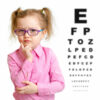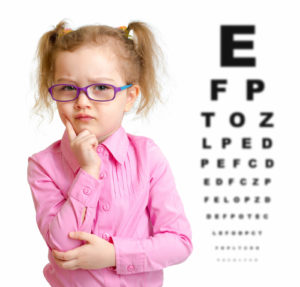
How to Care for Your Child’s Eyes Without Breaking the Bank
Childhood is a crucial period for visual health. However, child eye care isn’t always cheap. Some parents wonder how exactly they can get their child’s visual health up to par without overspending.
Young eyes take time to fully mature – babies lack distance vision, tracking, and even color vision at birth. They develop these abilities during the first few months of life. Even after infancy, vision doesn’t reach full maturity until later on in childhood. Some skills, such as convergence, take until about age seven.
Unfortunately, that development is far from risk-free. A wide range of visual problems can crop up during childhood. Some of these problems can have lasting effects if left untreated, and some of the effects can have a big impact. However, treating these conditions isn’t always cheap.
Even a simple eye exam can easily run you over $100 at some ophthalmologists. That’s before the additional costs for corrective lenses or medical procedures. Fortunately, anyone facing this problem can look for help. Aid comes in many forms, and plenty of NGOs, government programs, and clinics have their own ways of making sure that every child has access to adequate eye care.

Child Eye Care at School
Vision screening is a free service offered by many schools and a good first step to catching childhood vision disorders. Most testing is basic and is usually conducted by a trained school nurse.
A basic screening consists of an eye chart test (identifying smaller and smaller letters) to check visual acuity. Sometimes a color perception test is also done. This test helps to determine if a child is color blind or not. Some programs also encourage teacher observation and input. This lets struggling students get more in-depth screening to determine whether there are visual factors.
We can’t deny the value of widespread, free vision testing. It has already had an impact on academic performance, especially for struggling students. Still, school screenings do fall short in some areas. Most will only test visual acuity using the eye chart test. This can help to detect myopia (nearsightedness), but it doesn’t do much to help with different problems.
Strabismus (crossed eyes) and amblyopia (loss of visual acuity in one eye, which can result from untreated strabismus) are both relatively common in younger people. If caught early enough, these conditions can be treated effectively. These, and other disorders, often slip through the narrow scope of a free school screening.
Free Eye Exams
No matter how good a school’s screening program is, you’ll sometimes want to look for more expert advice. Impaired vision can make school a nightmare for our children. Reading and learning become much more difficult with an untreated disorder. Sometimes it causes a very literal headache that saps the fun out of school – not good for any student.
Some children seem to struggle or have difficulty with tasks that require acute vision regardless of the school screenings. In these cases, it’s best to head for a full clinical eye exam. As mentioned before, these don’t come cheap. However, if an office visit is a bit outside your budget, you may be able to find help.
VSP Vision Eyes of Hope is a program that offers free exams and lenses where needed. They’re an excellent place to start looking for a physician. Eyes of Hope works with an extensive network of community partners and you can search through their listings to find a doctor near you.
Vision to Learn is another great source. They provide everything from eye exams to glasses. The program works with school districts and provides some amazing resources. Check with your child’s school to see if this is an option for you.
Finding Lenses
Near- or farsightedness are the most common eye disorders a child is likely to encounter. Diagnosis with either one generally means one thing: it’s time to find some glasses.
Again, glasses aren’t always cheap. Finding a good pair means visiting an optometrist, sitting for measurements, and then actually buying the lenses and frames. In total, glasses can be quite expensive. Then there are the replacement costs that pop up when the first pair gets sat on, scratched, or misplaced. The cost can add up, but good vision is essential for life.
Again, the Eyes of Hope program can help. New Eyes is another option. If you qualify, New Eyes will purchase a new pair of prescription glasses for your child. They’re also good people to contact if you’ve got an outgrown pair lying around. They accept donations and redistribute used pairs to developing countries.
Vision to Learn also pops up again as a provider of frames and lenses. They provide an all-in-one service, so if you qualify for testing, they will generally provide your glasses too.
Of course, health insurance is also an option, though coverage can vary wildly by individual. Check your policy details to see if this is a worthwhile option for you. Sometimes paying a one-off deductible works out well!
Further Eye Care for Your Child
For anyone looking for a more complete care option, finding insurance is probably your best call. Low-cost or free health insurance is available through Medicaid or the Children’s Health Insurance Program (CHIP). Besides vision care, these programs also help to pay for more comprehensive care. This even includes hospital bills and prescription costs.
CHIP can cover a child until they turn 19. It’s a good all-around solution for childhood health care, not just optical care. Programs vary state by state, so be sure to contact a local source if you’re thinking about taking this route.
Note that not every physician will accept Medicaid or CHIP. It is relatively easy to find one using the program’s list of community partners though, so don’t be put off.
Home Health
Finally, a lot of the best eye care that a child can receive comes at little to no cost. Even better, it’s from a provider who’s already with them almost 24/7. We’re talking about you!
Parents are the first line of defense for a child’s vision, and one of the most effective. You’ll often be in the best place to notice any vision disorders. Keep watch for classic signs like squinting or headaches after watching television and other screens. These can be signs of decreased vision, as can sitting too close to the TV or struggling to spot distant objects.
A healthy diet can also provide a jump-start to healthy eyesight. While fine dining isn’t cheap, there are plenty of ways for you and your family to eat healthier on a budget.
Start by replacing sugary sodas, energy drinks, and juices with water. Sugar greatly increases a child’s odds of dealing with eye-harming diseases like diabetes or hypertension. Water also helps to maintain good levels of hydration. This is important for health in all areas, from cell function to your immune system.
There are also some foods that can give your vision a boost. Leafy greens are a great source of essential vitamins and nutrients. Spinach might not actually grant Popeye-style muscle, but it is packed with a long list of beneficial elements. With a little looking around, you can find plenty of ways to make these greens appetizing! It’s a great first step in providing the best eye care for your child so they can avoid those common vision disorders.
Our Rebuild Your Vision Ocu-Plus Formula Contains All 17 Vitamins, Minerals, and Herbal Supplements to Improve Your Eye Health!












My child has been diagnosed with convergence excess. I have the book, “Natural Vision Improvement.”. Are the exercises in that book able to help with this particular issue? And if so, can you direct me as to which exersizes will help?
Thank you!